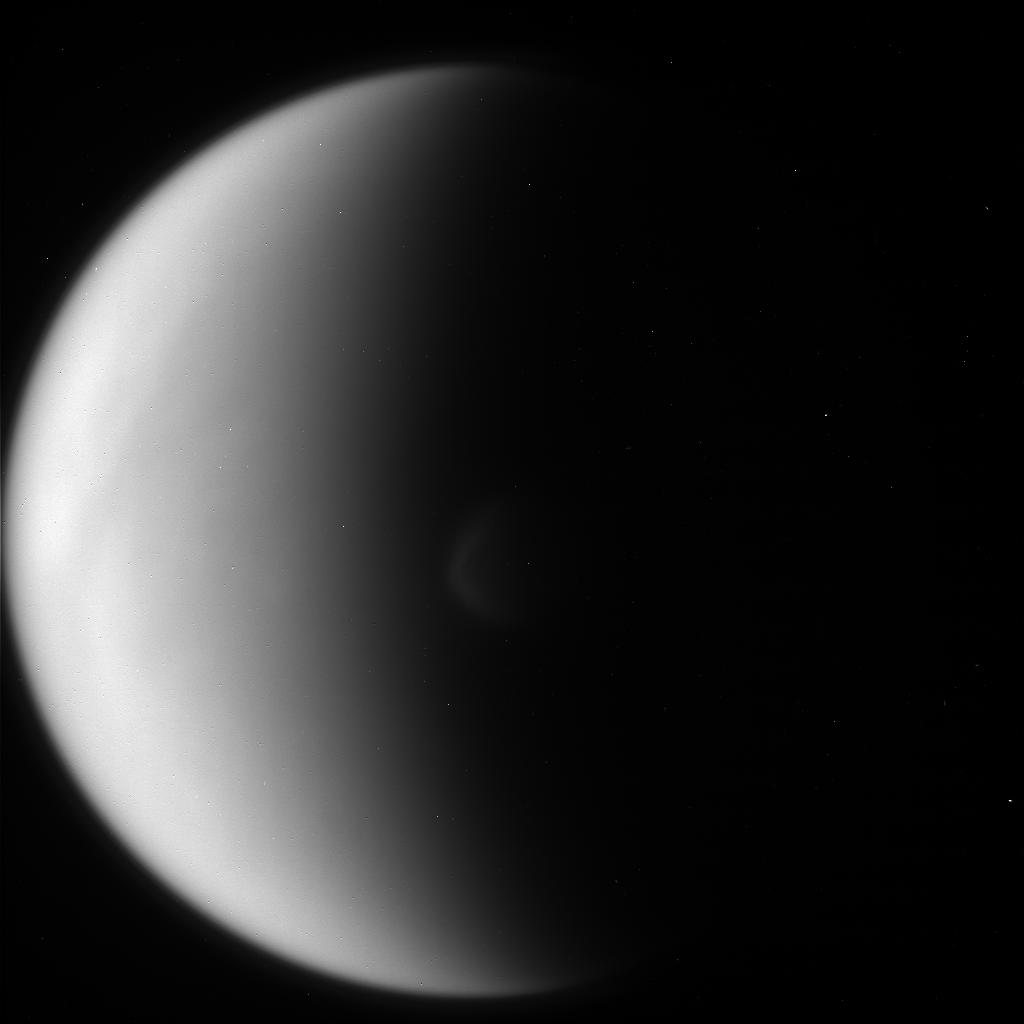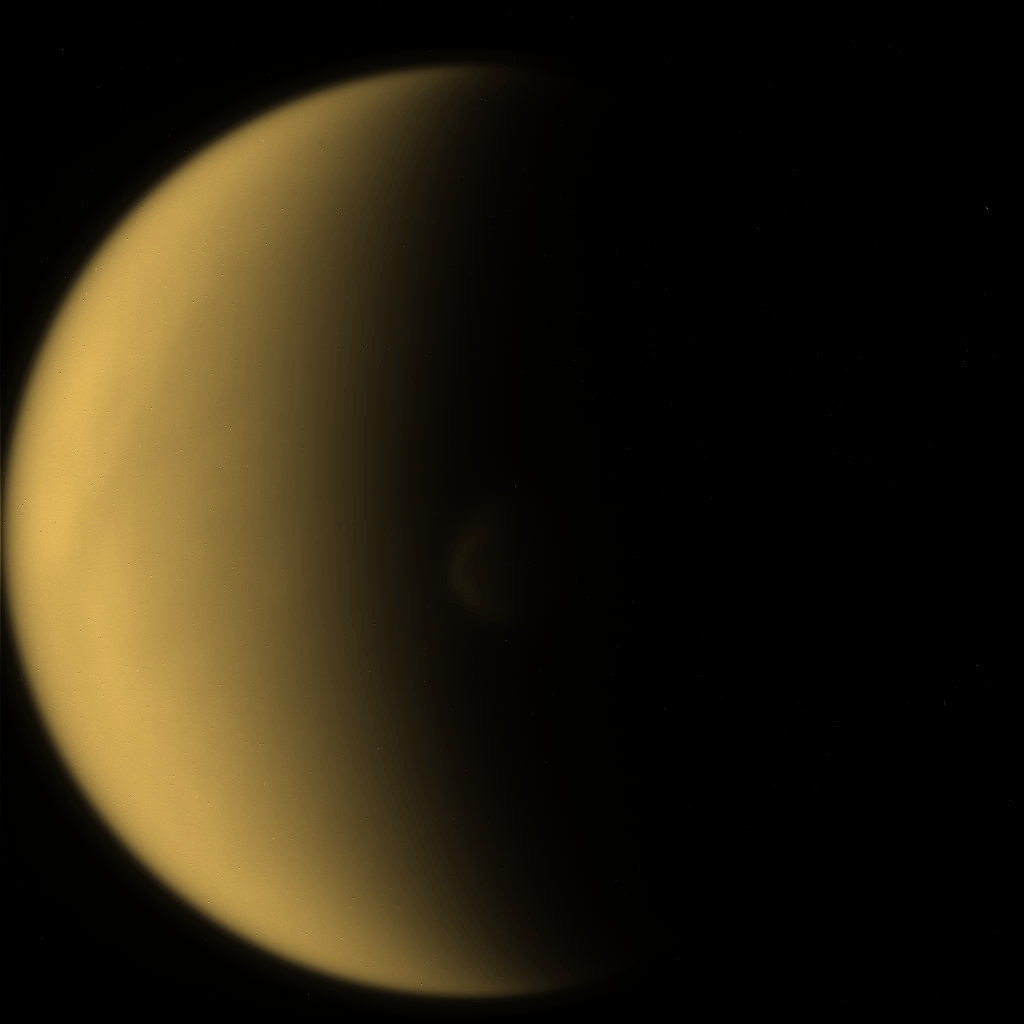February 22, 2022: A New Study Reveals How The Radiative Heating Of The Haze Of Titan Engenders A Superrotation Of Its Stratosphere
A new research work proposed by Motoki Sumi, Shin-ichi Takehiro, Wataru Ohfuchi, Hideko Nomura and Yuka Fujii, entitled "Superrotation of Titan's stratosphere driven by the radiative heating of the haze layer" and published in Arxiv shows the influence of the radiative heating of Titan's haze layer on the superrotation phenomenon of its stratosphere. The atmosphere of Saturn's largest moon is known to move faster than its surface. A phenomenon of superrotation is observed for the atmosphere of Titan or for the atmosphere of Venus. Both worlds contain a completely opaque atmosphere that prevents us from discerning surface features in the visible spectrum from outer space. The atmosphere of Titan is extremely cold whereas the atmosphere of Venus is extremely warm but the dynamics of both atmospheres presents some similarities. The atmosphere of the Opaque Moon rotates many times faster than its surface does for instance. That's also the case for Venus where the surface rotates extremely slowly compared to the surface of the Earth for instance. The atmosphere of Titan is particularly complex with a multitude of layers in its outer limits and with a thick haze layer containing various molecules like hydrocarbons or organics. The dynamics and the composition of that haze layer are closely related to solar radiations.
The researchers of the new study carried out numerical experiments mobilizing a General Circulation Model (GCM) to determine or evaluate the effects of the haze layer on the stratospheric superrotation. They resorted to a semi-gray radiation model of the atmosphere of the giant moon of Saturn following McKay et al. (1999) which incorporates the factor of sunlight absorption by haze particles. The simulations of the team did not incorporate the factor of the phase change of methane or the factor of the seasonal changes. The model based on the action of solar radiations on the thick haze layer of the Opaque Moon produced a configuration in which there is a global eastward wind around the equator with higher speeds at higher altitudes except at about 70 kilometers above the ground after 10^5 Earth days. The model predicts zonal wind profiles that are in line with the observations of that type of phenomenon even if the atmosphere does not appear to be in an equilibrium state. The analytical work of the team in its experiments implies that the quasi-stationary stratospheric superrotation is stabilized by the balance between the meridional circulation disconnected from the surface and the eddies that push angular momentum towards the equator.
The configuration in which the superrotation of the stratosphere is fueled by the balance between the meridional circulation disconnected from the ground and the eddies that bring angular momentum towards the equator is different to a certain extent from the so-called Gierasch mechanism but is also similar to a certain extent to that so-called Gierasch mechanism in which momentum is brought from the ground. The configuration which accounts for the stratospheric superrotation is likely to explain the no-wind area at the altitude of approximately 80 kilometers above the surface. Solar radiations are not particularly strong at the level of Saturn or Titan but they engender ionization processes in the upper atmosphere or in the haze of the Opaque Moon in particular. Titan's atmosphere contains several layers and the upper atmosphere is particularly dynamic with a complex chemistry closely related to the action of ultraviolet light from our star. The upper atmosphere of Titan whose blue or purple color contrasts with the dominating orange color of the atmosphere represents a soup of various chemicals that interact to form new molecules or particles such as hydrocarbons or organics.
The global haze of Titan is particularly interesting in terms of dynamics and chemistry. That haze is likely to produce complex hydrocarbons or organics that will tend to fall to the surface in the form of a type of snow if the molecules are heavy enough. The linear and parallel dunes extending over long distances found in the relatively dark areas of the low or middle latitudes may be regularly fueled by the haze rich in hydrocarbons and organics. That haze may engender a dark, brown or red sludge known as tholin on the surface of Saturn's largest moon. In the Outer Solar System, various icy or terrestrial worlds may contain tholins or a brown or dark sludge or mud rich in organics and hydrocarbons. Hydrocarbons are molecules containing hydrogen elements and carbon elements whereas organics are molecules containing hydrogen elements, carbon elements and oxygen elements. Planetologists regularly wonder what the level of complexity of the organics or hydrocarbons of Titan represents. Can the haze of the giant moon engender amino acids, proteins, lipids, sugars or a prebiotic chemistry ? That's a major question that is likely to tell us a lot regarding our own biological origin.
Saturn's largest moon evolves in an extremely harsh environment where the ambient temperature is around -180 degrees Celsius, -292 degrees Fahrenheit or 93 Kelvin. Due to the very low environmental temperatures, a world like Titan is heavy enough to retain a relatively significant atmosphere. That atmosphere can be particularly dynamic with the development of dynamic and transient clouds at various latitudes. The dynamics and the chemistry of Titan's atmosphere appear to be closely related to seasonal factors. Major cyclones or vortices can emerge and develop above the polar areas of Titan. A giant vortex rich in ethane, engulfing the north polar region, had been observed during the Winter season in the northern hemisphere. A high-altitude vortex had also been observed above the south polar region during the Autumn season in the southern hemisphere. Those vortices demonstrate the complexity or the dynamics of Titan's atmosphere which can significantly change during the long Titanian year. From time to time, cloud systems can develop in the relatively dry areas of the low or middle latitudes under the influence of seasonal factors closely related to the level of solar radiation by nature.
The meteorology of Titan involves methane, a molecule composed of carbon and hydrogen whose chemical formula is CH4. That meteorology based on methane can be compared to the meteorology of the Earth that is based on water whose chemical formula is H2O. Methane can represent about 5 percent of the air close to the surface on Saturn's largest moon. The atmosphere of the Earth and the atmosphere of Titan look alike to a certain extent since both atmospheres are dominated by molecular nitrogen in particular. In the harsh environment of Titan, methane can be present in its liquid form on the surface, can be present as a gas in the air, can condense and form clouds and can fall as rain. In the relatively warm environment of the Earth, methane can only be found in the form of natural gas. On Titan, water can be found on the surface in the form of ice. There can be rocks, stones or pebbles dominated by water ice on the Opaque Moon and those rocks, stones or pebbles will tend to be as hard as the typical rock one can encounter on Earth. However, some planetologists advance that there may be a layer dominated by liquid water beneath the external crust of the giant moon of Saturn.
The Earth appears to be much more humid than Titan since about 70 percent of its surface is covered with a stable liquid whereas the fraction of Titan's surface covered with a stable liquid is relatively limited. In fact, the low or middle latitudes of Titan appear to be particularly arid or dry since there is no clear sign of lake, sea or river and since the relatively dark areas which mark a sharp contrast with relatively bright areas tend to be dominated by Seif dunes or linear and parallel dunes extending over long distances. Curiously, the lakes, seas and rivers on Titan have been found in the high latitudes of each hemisphere. The radar views as well as the infrared or near-infrared views obtained from the Cassini orbiter during its long mission in the Saturn System from 2004 to 2017 have clearly shown that the north polar region was the most humid area of the giant moon. The largest pool of stable liquids on Titan is Kraken Mare. Kraken Mare which can be regarded as a sea can be found in the high latitudes of the northern hemisphere. Like any sea on Earth, Kraken Mare contains islands and is connected to drainage channels. Kraken Mare is likely dominated by liquid methane and may also contain ethane and dissolved nitrogen.
Three major pools of liquid can be discerned in the high latitudes of the Opaque Moon. Kraken Mare is clearly the largest pool of stable liquids but there are also Ligeia Mare and Punga Mare. A myriad of smaller lakes can also be identified in the north polar region. Some lakes appear to have partially evaporated since some rims can be discerned around them. At the end of the Cassini mission in the Saturn System, some clouds had been observed above the land of lakes, seas and rivers in the northern hemisphere demonstrating the potential meteorological cycle in the area. Seasonal factors must play a key role in the size, in the level, in the dynamics or in the composition of the lakes, seas and rivers in the high latitudes of the northern hemisphere. One can imagine heavy rainfall events in the area from time to time. One can imagine that the lakes, seas and rivers found in the high latitudes of the northern hemisphere contain more liquid during the Winter period due to net condensation processes and that they contain less liquid during the Summer period due to net evaporation processes. The south polar region which had been clearly observed during the Summer period in the area had revealed a major pool of liquid known as Ontario Lacus but the area appears much less humid than the north polar region. Is the area much more humid during the Winter season in the area ?
- To get further information on that news, go to: https://arxiv.org/abs/2202.08397#:~:text=Titan's%20stratosphere%20has%20been%20observed,presence%20of%20thick%20haze%20layer.&text=(1999)%2C%20which%20takes%20account,sunlight%20absorption%20by%20haze%20particles. .

